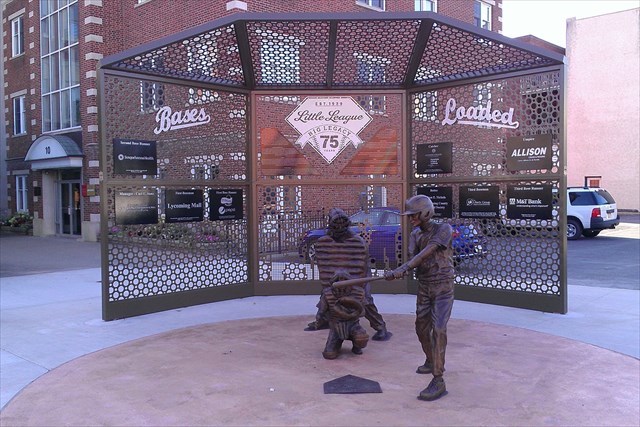
The information below can be found on the interpretive plaques on the Bases Loaded comemorative statues in Williamsport, PA.
Bases Loaded was comimissioned and built by the Williamsport/Lycoming Chamber of Commerce through its Lycoming County Visitors Bureau to commemorate the 75th anniversary of Little League Baseball and its continued history in the greater Williamsport Community since 1939.
Little League Baseball was started in Williamsport and has grown into the world's largest organized youth sports program. Bases Loaded was designed to commemorate the different decades over the 75 years of Little League Baseball. Each statue represents something significant within Little League's 75 year history.
The legacy of Williamsport as the birthplace of Little League Baseball is now depicted by 10 bronze statues at the four corners of Market Square in center city. The statues were created by Matt Glenn who owns Big Statues in Provo, Utah.
These statues represent all the participant in the league through the years, from when it was first founded to today. There are also statues represetnting the softball teams and Challenger division. Within the ten statues, there are a variety of boy and girl players, first edition and modern uniforms, as well as a mix of ethnicities.
The first, second and third basemen are in the uniforms from the first three teams back in 1939.Those teams were Lundy Lumber, Lycoming Dairy and Jumbo Pretzel.
Starting at Home Plate:
The umpire is dressed in a 1940's - 1950's era uniform. He represents all of the dedicated volunteers, both men and women, who have (and will) give their time and resources over the years to the Little League Baseball program.
The batter represents all present day youth (and adults) that dream of hitting the big home run to win the game. There is no logo on his uniform as he represents the past, present and future of the Little League Baseball program.
A = the number on the batter's jersey?
The catcher is an African-American boy wearing a 1950s-era uniform, with the letters "CS" on his cap and a number on his jersey, representing Jackie Robinson.
He represents the 1955 Cannon Street YMCA Little League team from Charleston, S.C., which, at the time, was the only African-American team in South Carolina. Each of the 61 all-white teams in the state refused to play Cannon Street, which led league officials to ban all 61 from competition, making them ineligible to qualify for the World Series.
However, the Cannon Street YMCA Little League team could not play because they had to have played at least one game in their region to have been accepted into the series and unfortunately that did not occur.
League officials invited the team to Williamsport for the World Series anyway, making players official guests of the organization, and the team attended all of the Series games and even bunked in the Lycoming College dorms with the other teams.
B = The number on the catcher's jersey?
Walk to First Base:
The first base runner represents all the girls who play Little League Baseball. Approximately one out of seven players of Little League is a girl. Little League Baseball offically allowed girls to play in 1974. The player rounding first base has the logo from the 25th Anniversary on her jersey. The ethnicity of the player represents the first international team from Mexico to play in the Little League World Series which occurred during the first twenty-five years of the sport.
C = The number on the first base runner's jersey?
D = The number on the first baseman's jersey?
Walk to Second Base:
The second base runner is wearing the logo from the 50th Anniversary on his jersey. The ethnicity of the player represents the growth of Little League Baseball during this period in the Asian continent, in particular Taiwan and Japan.
E = The number on the second base runner's jersey?
F = The number on the second baseman's jersey?
Continue to Third Base:
The third base runner represents Little League's Challenger program. He is wearing the logo for the 75th Anniversary on his jersey. It represents the timeframe of when the Challenger program was developed and has grown into an integral part of Little League's programming.
G = The number on the third base runner's jersey?
H = The number on the third baseman's jersey?
Go back to home plate, and sit on the bench with Carl E. Stotz.
This is the only statue that represents an individual person. Carl Stotz, with the help of family and friends, worked tirelessly to create a baseball experience at a level for all youth to enjoy. He provided a foundation for adults to teach basic principles and values to children at the same time. Today, Little League Basball is played in over 100 countries by over 2 1/2 million children. It is due to his vision and energy that we have this sport identified with the Williamsport and Lycoming County community.
I = The number of players listed on his roster?
A= B= C= D= E= F= G= H= I=
The cache location is at
N (B-C) (E-C)(C+F).(A)(D+F)(A+D)
W 0(A+B+G+H) (D)(E+H).(A+D)(I-D)(C+D)